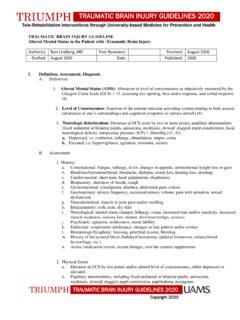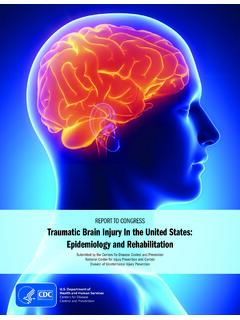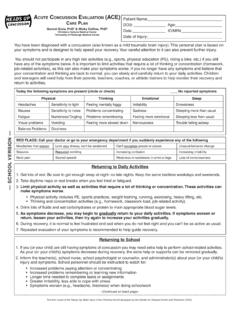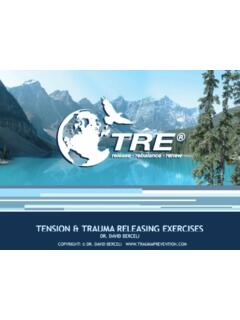Transcription of Management of Post Traumatic Brain Injury Agitation
1 TRIUMPH Traumatic Brain Injury GUIDELINES. Tele-Rehabilitation Interventions through University-based Medicine for Prevention and Health Management of post Traumatic Brain Injury (TBI) Agitation Author(s): Peer Reviewed: Finalized: Drafted: Date: Published: 2020. I. Definition, Assessment, Diagnosis A. Agitation Definitions: No consensus 1. Subtype of delirium unique to TBI which occurs during period of post - Traumatic amnesia (PTA period of time in which new memory formation is impaired), characterized by excess of behavior that includes some combination of aggression, disinhibition, akathisia, disinhibition, and emotional liability.
2 [2], [3], [5\. 2. State of aggression during the period of post - Traumatic amnesia, in the absence of other physical, medical or psychiatric causes, with a score of 21 on the Agitated Behavior Scale (ABS) [6]. B. Agitation Assessment: 1. Agitated Behavior Scale: reliable and validated measure that describes level of Agitation .[4]. a. Helpful for monitoring patient's recovery progression and assessing effectiveness of interventions b. High inter-rater reliability [7]. c. Rating of 1 to 4 (based on severity) for 14 different behaviors d.]
3 Can be completed quickly and via observation [6]. 2. Galveston Orientation and Amnesia Test (GOAT): [8]. a. Reliable and valid indicator of PTA in TBI patients [9]. b. Score of 78 or more on three consecutive occasions is considered to indicate that patient is out of PTA. c. Can be administered daily until patient is out of PTA. 3. Rancho Los Amigos (RLA) Scale/ Levels of Cognitive Functioning Scale a. Represents the typical sequential progression of recovery in TBI. b. Stage IV: Confused, Agitated Response c. Barriers: These patients have deficits in attention, memory, initiation, problem solving, sequencing, information processing speed, and safety awareness.
4 Anasognosia (lack of awareness of deficits) is also a challenge. 4. Other scales used: The Overt Agitation Severity Scale and the Neurobehavioral Rating Scale[5],[10]. TRIUMPH Traumatic Brain Injury GUIDELINES 2020. Copyright 2020. TRIUMPH Traumatic Brain Injury GUIDELINES. Tele-Rehabilitation Interventions through University-based Medicine for Prevention and Health C. Agitation Diagnosis [3], [4], [5]. 1. A diagnosis of exclusion after physical, medical, psychiatric, and neurological conditions have been ruled out 2. Score of 21 or greater on ABS.
5 3. Can also result from physical, medical, psychiatric, and neurological conditions: a. Physical: i. Pain (fractures, post -operative, heterotopic ossification, spasticity, wounds, or other noixious stimuli). ii. Environmental: Excessive stimulation, Temperature, Restraints - ICU Syndrome : acute state of confusion seen even in patients without primary Brain pathology, secondary to constant stimulation in ICU - vital signs, alarms, medication administration, constant lighting, and ambient hallway noise. [11],[12]. iii. Tubes/lines b.
6 Medical: i. Metabolic disturbance (electrolytes, thyroid, hypoglycemia). ii. Infection iii. Hypoxemia, pulmonary embolism iv. Urinary retention/incontinence v. Nausea, Constipation c. Neurological: i. Hydrocephalus ii. Seizures iii. Intracranial mass lesion/rebleed iv. Headache d. Psychiatric: i. Premorbid or exacerbation of premorbid Personality/Psychotic/Anxiety/Mood disorders ii. Sundowning in patients with dementia e. Substance/medication related: i. Iatrogenic ii. Acute intoxication iii. Withdrawal [6]. -Alcohol: Hypertension, tachycardia, hallucinations, disorientation, Agitation -Opioid: Restlessness, abdominal pain, yawning, piloerection -Benzodiazepine: Hypertension, tachycardia, diaphoresis, tremors, hyperthermia, and seizures 4.
7 Work up of Agitated patient: CMP, Thyroid function tests, CBC with differential, UA, B12/Folate, Urine toxicology screen, CT/MRI of Brain , EEG, XRay II. Management and Treatment Recommendations A. FIRST LINE: Environmental Modification[6]. TRIUMPH Traumatic Brain Injury GUIDELINES 2020. Copyright 2020. TRIUMPH Traumatic Brain Injury GUIDELINES. Tele-Rehabilitation Interventions through University-based Medicine for Prevention and Health 1. Reduce stimuli: a. Light, noise, distractions (especially at night) place patient in bed, draw curtains, turn off television, etc.
8 B. Limit number of visitors at one time c. Staff and family should speak in low volume, slowly, one at a time 2. Avoid/minimize restraints: Use non-contact restraints if able (safety net beds), padded hand mittens, one-to-one staff supervision 3. Minimize tubes and lines: May cover them (abdominal binder, etc). 4. Frequent re-orientation by staff and family 5. Obtain any hearing devices or vision aids from home to improve orientation 6. Consistent schedule and staff 7. Timed toileting 8. Create a familiar environment: Allow family to bring in personal possessions [15].
9 9. Monitor sleep cycle and sleep quality a. Consider use of Trazodone, Melatonin B. Behavioral Modification 1. Allow patient to pace (if safe) or be walked /wheeled around by staff to address akathisia/restlessness. 2. Mobile patients may benefit from a closed unit or sensors for safety 3. De-escalation techniques (see prevention and education section below) [14]. 4. Structured behavioral programs[6],[15]. a. Limited application depending on patient's level of cognitive and communication impairment C. Pharmacologic Management 1. Agents which slow cognition may prolong/exacerbate Agitation .
10 [14]. Dopaminergic agents should be avoided if able as they can prolong PTA and slow cognitive recovery[5]. 2. Antipsychotics: a. Typical Antipsychotics: Not recommended as first line, rescue only i. Haldol: -shown to slow cognitive recovery -shown to slow motor recovery in rat model[16]. -associated with longer time in PTA[17]. -Easily accessible in the hospital and can be given IM, IV: useful for patients who are imminently a danger to self or others. ii. Droperidol: -Also available in IM. -Found to be faster and superior to Haldol, Ativan, and Benadryl in controlling acute Agitation [18].




